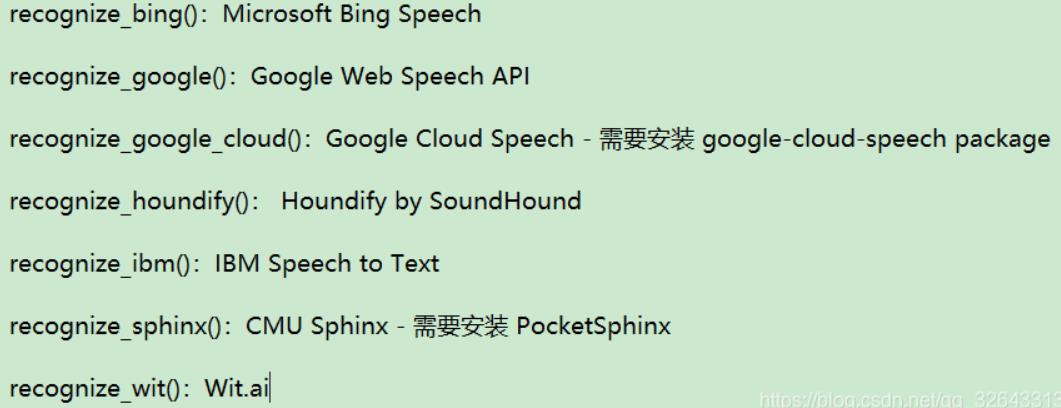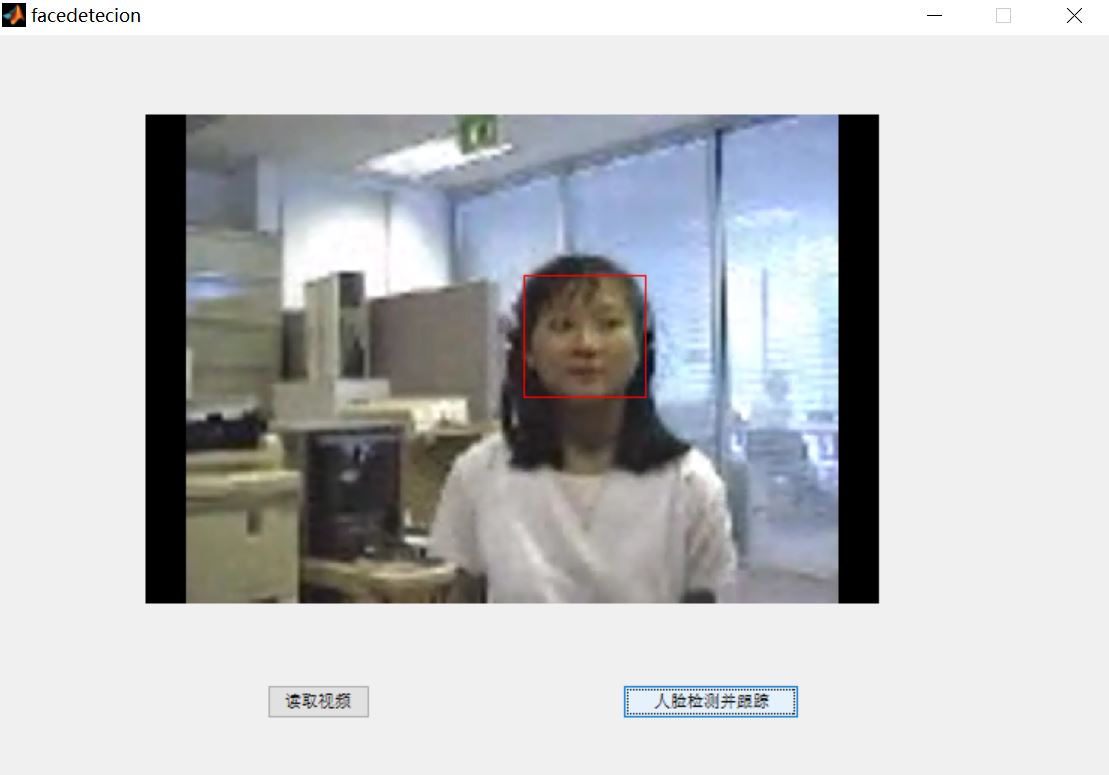视频话题识别与跟踪 - demo 问题总结1.1-视频处理
Posted 小羊小羊小羊羊羊
tags:
篇首语:本文由小常识网(cha138.com)小编为大家整理,主要介绍了视频话题识别与跟踪 - demo 问题总结1.1-视频处理相关的知识,希望对你有一定的参考价值。
目的:视频 --》音频 --》文本(语音识别)
-
moviepy库可将MP4文件转换为MP3文件
-
pydub库将MP3文件转换为flac文件,但是必须安装FFmpeg
实际上pydub库仅支持WAV格式文件的转换,FFmpeg可以支持多种格式音频转换
在官网下载FFmpeg压缩包,解压后将bin文件夹添加至系统环境变量,再安装pydub库即可正常使用
安装了FFmpeg后,pydub也支持MP4文件转MP3文件
以下代码是github上的例子:import os import glob from pydub import Audiosegment video_dir = '/home/johndoe/downloaded_videos/' # Path where the videos are located extension_list = ('*.mp4', '*.flv') os.chdir(video_dir) for extension in extension_list: for video in glob.glob(extension): mp3_filename = os.path.splitext(os.path.basename(video))[0] + '.mp3' AudioSegment.from_file(video).export(mp3_filename, format='mp3') -
speech_recognition库可以进行语音识别,但不支持MP3文件,所以才要先将MP3文件转换为flac文件
SpeechRecognition支持语音文件类型:
WAV: 必须是 PCM/LPCM 格式
AIFF
AIFF-C
FLAC: 必须是初始 FLAC 格式;OGG-FLAC 格式不可用 -
SpeechRcognition的识别类(器)有7个

但只有recognition_sphinx()可与CMU Sphinx 引擎脱机工作, 其他六个都需要连接互联网(调用API)。另外SpeechRecognition 附带 Google Web Speech API 的默认 API 密钥,可直接使用它 -
我选用了recognition_sphinx,在安装时发现要安装wheel和swig,wheel可以直接pip安装,但是swig不行
官网下载swig压缩包,解压后添加环境变量即可正常安装sphinx。cmd下可以正常安装,pycharm中依旧报错
-
SpeechRcognition和recognition_sphinx都安装好后,要在SpeechRcognition的安装文件夹下找到pocketsphinx-data文件夹,创建新文件夹“zh-CN”存放中文声学模型、语言模型和字典文件,这样才能进行中文识别。
pocketsphinx需要安装的中文语言、声学模型
下载地址:http://sourceforge.net/projects/cmusphinx/files/Acoustic%20and%20Language%20Models/
下载cmusphinx-zh-cn-5.2.tar.gz并解压,加入zh-CN文件夹,zh_cn.cd_cont_5000文件夹重命名为acoustic-model、zh_cn.lm.bin命名为language-model.lm.bin、zh_cn.dic中dic改为dict格式
但是感觉识别的准确度不太好
使用Google Web Speech API,会报错“由于连接方在一段时间后没有正确答复或连接的主机没有反应,连接尝试失败。”
人脸识别基于matlab GUI人脸实时检测与跟踪含Matlab源码 673期
一、简介
如何在视频流中检测到人脸以及人脸追踪。对象检测和跟踪在许多计算机视觉应用中都很重要,包括活动识别,汽车安全和监视。所以这篇主要总结MATLAB的人脸检测和跟踪。
首先看一下流程。检测人脸——>面部特征提取——>脸部追踪。
二、源代码
unction varargout = facedetecion(varargin)
% FACEDETECION MATLAB code for facedetecion.fig
% FACEDETECION, by itself, creates a new FACEDETECION or raises the existing
% singleton*.
%
% H = FACEDETECION returns the handle to a new FACEDETECION or the handle to
% the existing singleton*.
%
% FACEDETECION('CALLBACK',hObject,eventData,handles,...) calls the local
% function named CALLBACK in FACEDETECION.M with the given input arguments.
%
% FACEDETECION('Property','Value',...) creates a new FACEDETECION or raises the
% existing singleton*. Starting from the left, property value pairs are
% applied to the GUI before facedetecion_OpeningFcn gets called. An
% unrecognized property name or invalid value makes property application
% stop. All inputs are passed to facedetecion_OpeningFcn via varargin.
%
% *See GUI Options on GUIDE's Tools menu. Choose "GUI allows only one
% instance to run (singleton)".
%
% See also: GUIDE, GUIDATA, GUIHANDLES
% Edit the above text to modify the response to help facedetecion
% Last Modified by GUIDE v2.5 01-May-2017 19:18:42
% Begin initialization code - DO NOT EDIT
gui_Singleton = 1;
gui_State = struct('gui_Name', mfilename, ...
'gui_Singleton', gui_Singleton, ...
'gui_OpeningFcn', @facedetecion_OpeningFcn, ...
'gui_OutputFcn', @facedetecion_OutputFcn, ...
'gui_LayoutFcn', [] , ...
'gui_Callback', []);
if nargin && ischar(varargin{1})
gui_State.gui_Callback = str2func(varargin{1});
end
if nargout
[varargout{1:nargout}] = gui_mainfcn(gui_State, varargin{:});
else
gui_mainfcn(gui_State, varargin{:});
end
% End initialization code - DO NOT EDIT
% --- Executes just before facedetecion is made visible.
function facedetecion_OpeningFcn(hObject, eventdata, handles, varargin)
% This function has no output args, see OutputFcn.
% hObject handle to figure
% eventdata reserved - to be defined in a future version of MATLAB
% handles structure with handles and user data (see GUIDATA)
% varargin command line arguments to facedetecion (see VARARGIN)
% Choose default command line output for facedetecion
handles.output = hObject;
% Update handles structure
guidata(hObject, handles);
% UIWAIT makes facedetecion wait for user response (see UIRESUME)
% uiwait(handles.figure1);
% --- Outputs from this function are returned to the command line.
function varargout = facedetecion_OutputFcn(hObject, eventdata, handles)
% varargout cell array for returning output args (see VARARGOUT);
% hObject handle to figure
% eventdata reserved - to be defined in a future version of MATLAB
% handles structure with handles and user data (see GUIDATA)
% Get default command line output from handles structure
varargout{1} = handles.output;
% --- Executes on button press in pushbutton1.
function pushbutton1_Callback(hObject, eventdata, handles)
% hObject handle to pushbutton1 (see GCBO)
% eventdata reserved - to be defined in a future version of MATLAB
% handles structure with handles and user data (see GUIDATA)
global myvideo myvideo1;
[fileName,pathName] = uigetfile('*.*','Please select an video');%文件筐,选择文件
if(fileName)
fileName = strcat(pathName,fileName);
fileName = lower(fileName);%一致的小写字母形式
else
% J = 0;%记录区域生长所分割得到的区域
msgbox('Please select an video');
return; %退出程序
end
% boxlnserter = vision.ShapeInserter('BorderColor','Custom','CustomBorderColor',[255 0 0]);
% videoOut = step(boxlnserter,videoFrame,bbox);
myvideo = VideoReader(fileName);
nFrames = myvideo.NumberOfFrames
vidHeight = myvideo.Height
vidWidth = myvideo.Width
mov(1:nFrames) = struct('cdata',zeros(vidHeight,vidWidth,3,'uint8'),'colormap',[]);
B_K = read(myvideo,1);
axes(handles.axes1);
imshow(B_K);
% myvideo = VideoReader(fileName);
% nFrames = myvideo.NumberOfFrames
% vidHeight = myvideo.Height
% vidWidth = myvideo.Width
% mov(1:nFrames) = struct('cdata',zeros(vidHeight,vidWidth,3,'uint8'),'colormap',[]);
% B_K = read(myvideo,1);
% axes(handles.axes1);
% imshow(B_K);
% --- Executes on button press in pushbutton2.
function pushbutton2_Callback(hObject, eventdata, handles)
% hObject handle to pushbutton2 (see GCBO)
% eventdata reserved - to be defined in a future version of MATLAB
% handles structure with handles and user data (see GUIDATA)
global myvideo myvideo1;
nFrames = myvideo.NumberOfFrames
vidHeight = myvideo.Height
vidWidth = myvideo.Width
mov(1:nFrames) = struct('cdata',zeros(vidHeight,vidWidth,3,'uint8'),'colormap',[]);
faceDetector = vision.CascadeObjectDetector();
% videoFileReader = vision.VideoFileReader(fileName);
% videoFrame = step(videoFileReader);
三、运行结果

四、备注
完整代码或者咨询添加QQ 1564658423
以上是关于视频话题识别与跟踪 - demo 问题总结1.1-视频处理的主要内容,如果未能解决你的问题,请参考以下文章
dlib库包的介绍与使用,opencv+dlib检测人脸框opencv+dlib进行人脸68关键点检测,opencv+dlib实现人脸识别,dlib进行人脸特征聚类dlib视频目标跟踪